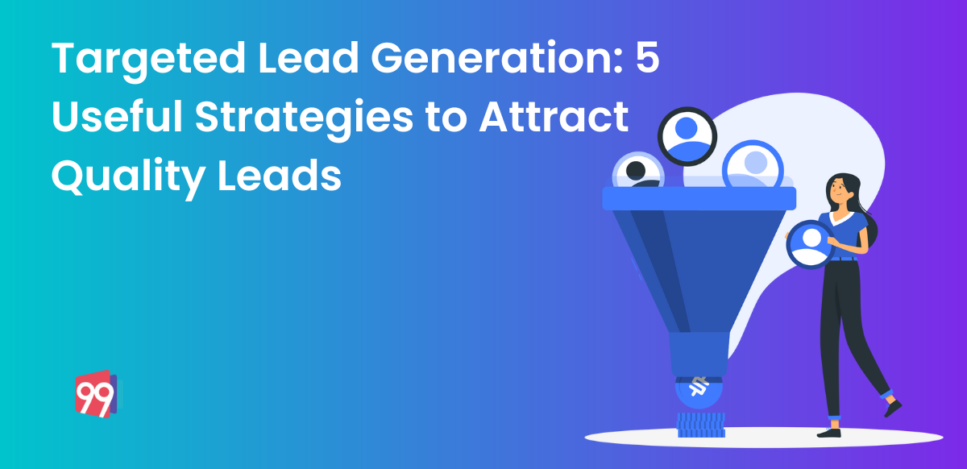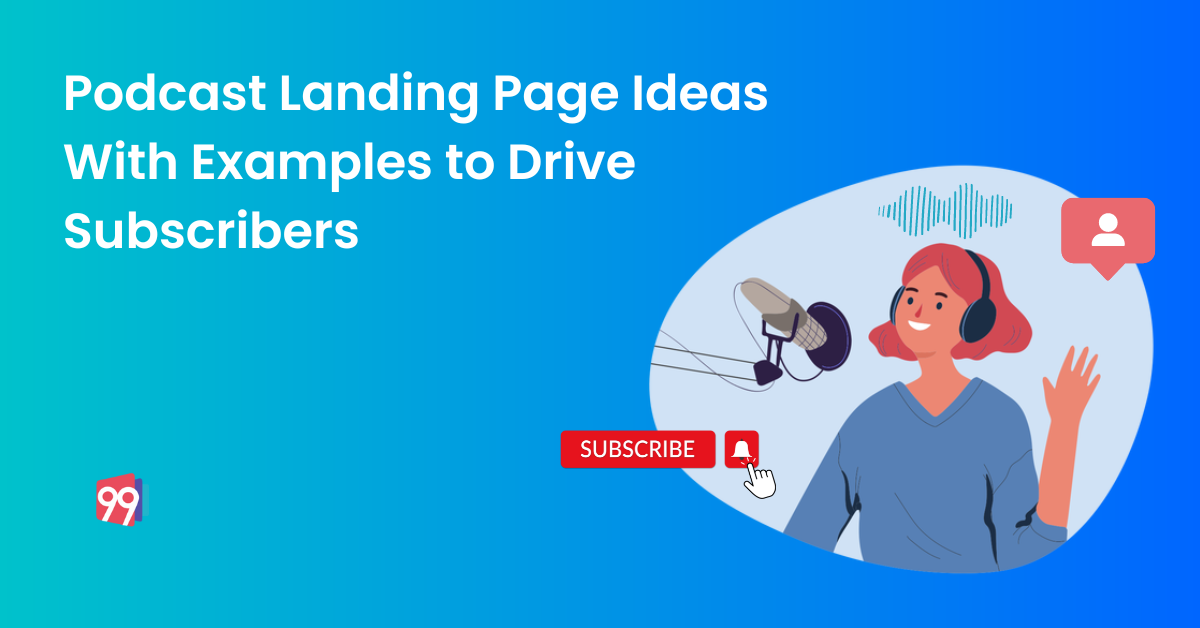Targeted lead generation stands as the solution to the enduring challenge faced by sales and marketing teams: generating leads with a higher likelihood of converting. Brands grappling with the struggle to attract quality leads may find that the absence of targeted lead generation strategies in their sales funnel is a key contributing factor.
Targeted lead generation is not just about capturing leads, but capturing high-quality leads with a higher likelihood of conversion. Focusing on lead quality rather than quantity can prevent burdening the sales team with unproductive leads and wasting time in the sales process.
To make lead generation operations more effective and focused on capturing quality leads, targeting becomes imperative. By honing in on specific audiences that genuinely require the services offered, brands can optimize their marketing efforts for greater impact.
1. What is Targeted Lead Generation?
Lead generation succeeds when the companies market their services to the right audience. But among so many promotional platforms and advertising channels, it can become hard to filter out the right leads. Targeted lead generation aims to solve this problem by defining a company’s target audience through several criteria. It helps identify the target audience on various platforms easier and generates marketing strategies accordingly.
Marketers can base the criteria for defining their target audience on many factors like:
- Demographics: It is about the personal details of a prospect like age, gender, relationship status, education, etc.
- Firmographics: It covers the professional details of prospects like job profile, name of the company they work for, experience, speciality, etc.
- Behavioural: It captures a prospect’s online behaviour like page visits, lead magnet downloads, and other brand interactions.
Companies can build different buyer personas or ideal customer profiles based on these factors and target them.
Types of Targeted Lead Generation
a) Use Referrals Offers
The established clients of a company can have a vast network of friends working in the same industry.
A referral program encourages the paying clients to refer your services to other suitable prospects. Businesses can make referral offers through free products, discounts, or cash rewards. Build a referral program that offers personalised features to clients to motivate them to become your brand’s spokesperson and share it with others.
Businesses can also create referral landing pages that offer exclusive deals or rewards for referrals. We can also use lead nurturing emails encouraging customers to refer their friends and family members. As limited offers, Freemiums and gift coupons create the urgency required to push paying clients to recommend your services.
b) Build Landing Pages
Landing pages are an essential part of targeted lead generation. It’s a simple yet powerful way to capture quality leads through concise and direct content. It has a simple design and focuses on immediately capturing the visitor’s attention.
Whether you are looking to generate leads for real estate, restaurants, or any other business, brands can utilise landing pages for all types of marketing. Landing pages are suitable for usage at every sales funnel stage and are mostly paired with paid advertisements for faster lead conversion.
The landing page’s content must discuss how the offered services meet prospects’ needs and present an interactive user experience. A landing page must include a specific CTA that guides the visitor toward taking action.
Businesses must use lead generation landing pages specially built for generating leads through compelling copy and design.
Suggested Read: 5 Essentials of an Effective Lead Generation Landing Page
c) Attract with Lead Magnets
A prospect’s search for service begins with looking for answers to their pain points. For targeted lead generation, businesses must curate content that addresses the concerns of their target audience. To leverage this content efficiently, marketers must use it as lead magnets to generate more conversions.
A lead magnet is a piece of content specifically designed to capture a prospect’s attention and convince them to take a specific action in exchange for the information.
Lead magnets can be anything from an ebook download to whitepaper, checklists, cheat sheet, etc. Businesses can increase conversion rates by providing valuable content relevant to prospects and easy access while driving more leads through their funnel.
Brands can use lead magnets on landing pages, websites, social media channels, and other suitable platforms. A dedicated landing page for a lead magnet is also a good way of capturing visitors’ data.
d) Focus on Paid Advertising
Google, Facebook, Instagram, Twitter, and LinkedIn are some famous channels where paid advertising is renowned for targeted lead generation. Most paid advertising platforms work based on user search history and display ads relevant to their searches.
For example, if a real estate agent in the UK is running a paid advert, then users who will search for “real estate agent in the UK”, “real estate UK”, or “property in the UK” will get the targeted ad in their feed.
Paid advertising works well when paired with the right landing page as it increases the impact of marketing and provides users with to-the-point information. Adverts can be of two types: display ads or pay-per-click ads. While display ads appear on third-party websites, pay-per-click ads appear at the top of Google searches and in the feed of social media channels.
Depending on the target audience, marketers must choose the right platform for running ads when directed correctly; they can generate plenty of high intent leads.
e) Bring in Web Forms
When a lead comes closest to an ideal client, companies consider it a qualified lead. Every company has its method for qualifying targeted leads. Questions they usually ask to see whether a prospect is interested or if they fit a buyer’s persona or not?
Before approaching a prospect, companies must ask a few questions to qualify them before sending them over to the sales team. Companies can include the questions in the contact form or the landing page.
This method gives you more than just personal information from your contact form. It becomes easier for marketers to tell if a qualified lead or if lead nurturing is required.
Ensure the question is straightforward and doesn’t include more than two questions. Use a drop-down menu with the question so the client can quickly select an answer without overthinking it. They also ensure your form is straightforward and does not take up too much of their time.
f) Social Media Engagement
Social media engagement is a key strategy in targeted lead generation. It involves connecting with the target audience across various social media platforms to build relationships, foster trust, and generate leads. This approach helps create a sense of community and can effectively generate quality leads.
Consistent online presence requires regular, audience-focused content posting, two-way communication, targeted social media advertising, live sessions, Q&A sessions, webinars, and user-generated content. This approach fosters trust and builds a sense of community.
g) SEO and Content Optimization
SEO and content optimization are key strategies in targeted lead generation, helping improve search engine rankings and attract organic traffic from the desired target audience.
Comprehensive keyword research is crucial for improving search engine visibility. Integrating keywords into website content helps align with the audience’s search intent. Crafting informative posts addressing the audience’s needs positions the brand as an authoritative source.
Optimizing meta tags, descriptions, and headers ensures clarity and relevance. Building quality backlinks from reputable sources contributes to the website’s authority. Regularly updating content maintains its relevance in targeted lead generation.
h) Account-Based Marketing (ABM)
ABM is a targeted lead generation approach that prioritizes personalized outreach to identified target accounts rather than broader audience engagement.
The first step in ABM is identifying high-value target accounts aligned with the ideal customer profile. This involves tailoring marketing campaigns and content to suit the unique needs of each target account for more personalized outreach.
Personalized outreach methods, like direct mail, personalized emails, and targeted advertising, are used to establish direct connections with key decision-makers. Collaboration with sales teams ensures that marketing efforts align with account-specific goals, prioritizing quality over quantity in targeted lead generation.
ABM campaign success is measured based on the engagement and conversion rates of the targeted accounts.
i) Chatbot Integration
Chatbot integration is a strategic move in targeted lead generation. Chatbots engage with visitors, answer queries, and efficiently capture leads, all in an automated system.
Chatbots improve user experience by responding instantly to common queries and implementing lead capture forms. They can guide visitors through the website and offer personalized interactions based on user behavior with the help of artificial intelligence capabilities.
Highly qualified leads can be identified and transferred to human representatives for further engagement and conversion.
j) Customer Retention Strategies
Customer retention strategies are essential for targeted lead generation. By retaining and turning existing customers into advocates, businesses can benefit from positive word-of-mouth marketing and generate more leads.
Creating loyalty programs, showcasing customer testimonials, and implementing referral programs are effective ways to encourage repeat business and build credibility among potential leads. Consistent communication with customers through newsletters and personalized communications strengthens relationships while implementing improvements based on customer feedback demonstrates responsiveness and enhances overall satisfaction and loyalty.
How do you get targeted leads?
To attract and convert potential customers, take a targeted approach. Tailor your efforts based on your audience and follow these steps: define your ideal customer, leverage various channels, and create a lead generation process that converts leads into customers.
a) Define Your Target Audience
Clearly define the characteristics and preferences of your ideal customers for effective targeted leads.
Understand the demographics, interests, behaviors, and challenges of the audience you want to target.
b) Create Buyer Personas
Develop detailed buyer personas based on your target audience for precise targeted leads.
These personas should represent the key characteristics and preferences of your ideal customers.
c) Optimize Your Landing Page
Ensure your landing page is optimized to capture and convert leads effectively in the realm of targeted leads.
Utilize relevant keywords, create compelling content, and enhance the overall user experience to attract and engage visitors from your target audience.
d) Content Marketing
Develop high-quality content that directly addresses your target audience’s needs and pain points for strategic targeted lead generation.
Share this content through blog posts, ebooks, whitepapers, and other formats to establish your expertise and attract leads.
e) Social Media Marketing
Utilize social media platforms to engage with your target audience in the context of targeted lead generation.
Share relevant content, participate in discussions, and use targeted advertising to reach specific demographics within your audience.
f) Email Marketing
Build and nurture an email list by offering valuable content, promotions, or newsletters tailored for targeted lead generation.
Segment your email list based on customer characteristics to send personalized and targeted messages.
g) Networking and Partnerships
Attend industry events, conferences, and networking sessions to connect with potential leads in the context of targeted lead generation.
Collaborate with complementary businesses for cross-promotion and mutual lead generation.
h) Referral Programs
Encourage satisfied customers to refer your products or services to their network for enhanced targeted lead generation.
Implement referral programs with incentives to motivate customers to share their positive experiences.
i) Use Lead Magnets
Offer lead magnets such as ebooks, webinars, or free trials to capture potential leads’ contact information in the targeted lead generation strategy.
Provide value in exchange for their details.
j) Analytics and Iteration
Regularly analyze the performance of your lead generation strategies using analytics tools in the context of targeted lead generation. Adjust your approach based on the data to continually improve targeting and results.
Conclusion
Targeted lead generation is successful when a company fully understands its target audience’s pain points and concerns and answers them with the help of content and services.
Methods that help in a targeted lead generation get tailored according to the prospects’ search queries and relevancy. Such lead generation strategies attract and engage visitors with the right keywords and motivate them to convert.
The right web form paired with the right landing page and paid advertisement makes it easier to identify qualified leads. Targeted lead generation paves the way for new business opportunities by saving time and effort and redirecting it to other essential company goals.
Other interesting reads:
Lead Generation for Technology Companies: 8 Tips for Creating Great User Experience
Demand Generation vs Lead Generation: What You Need to Know
5 Best Practices For Automotive Lead Generation Campaigns
Check Out Our Featured Templates:





